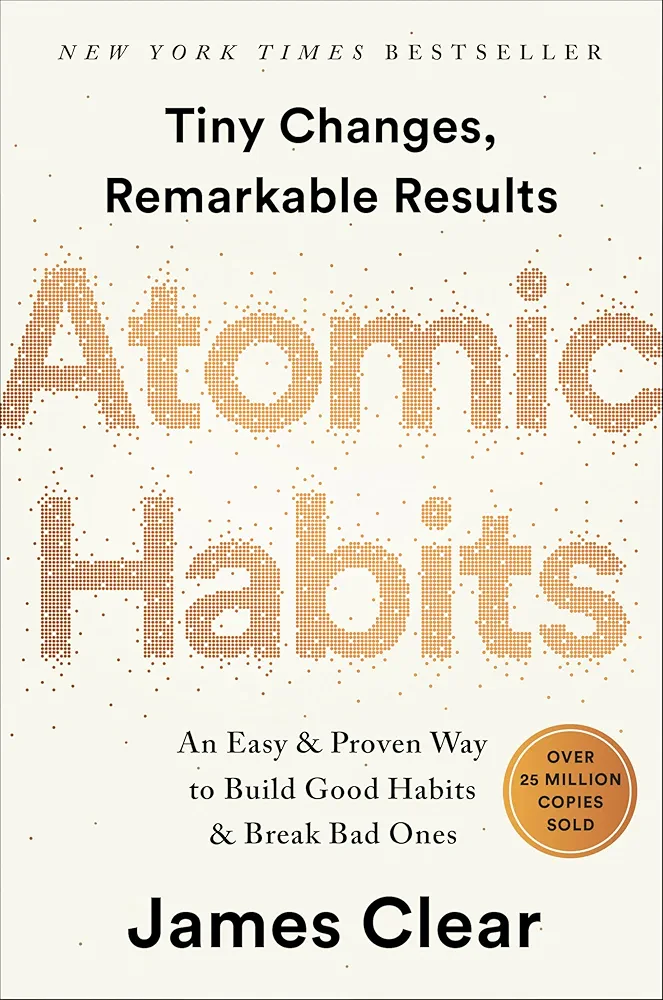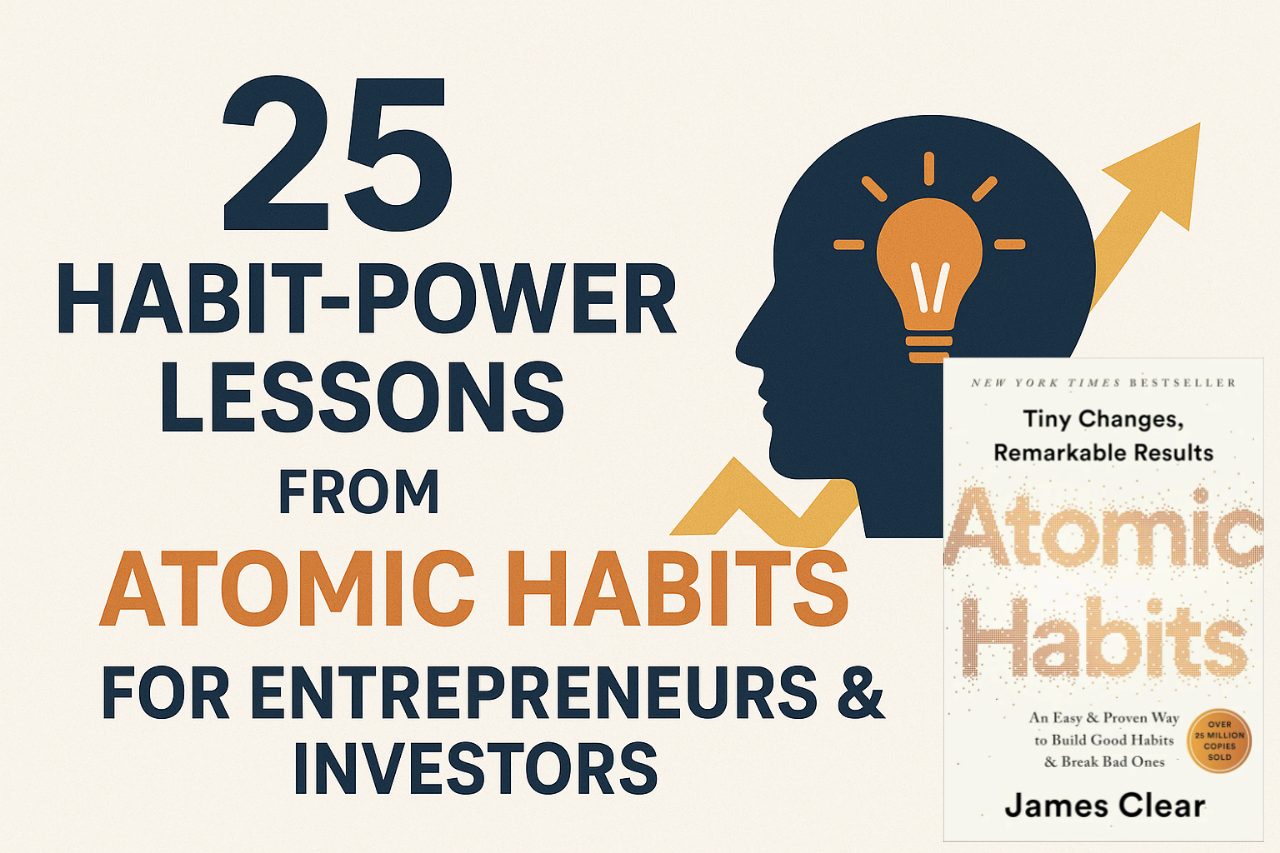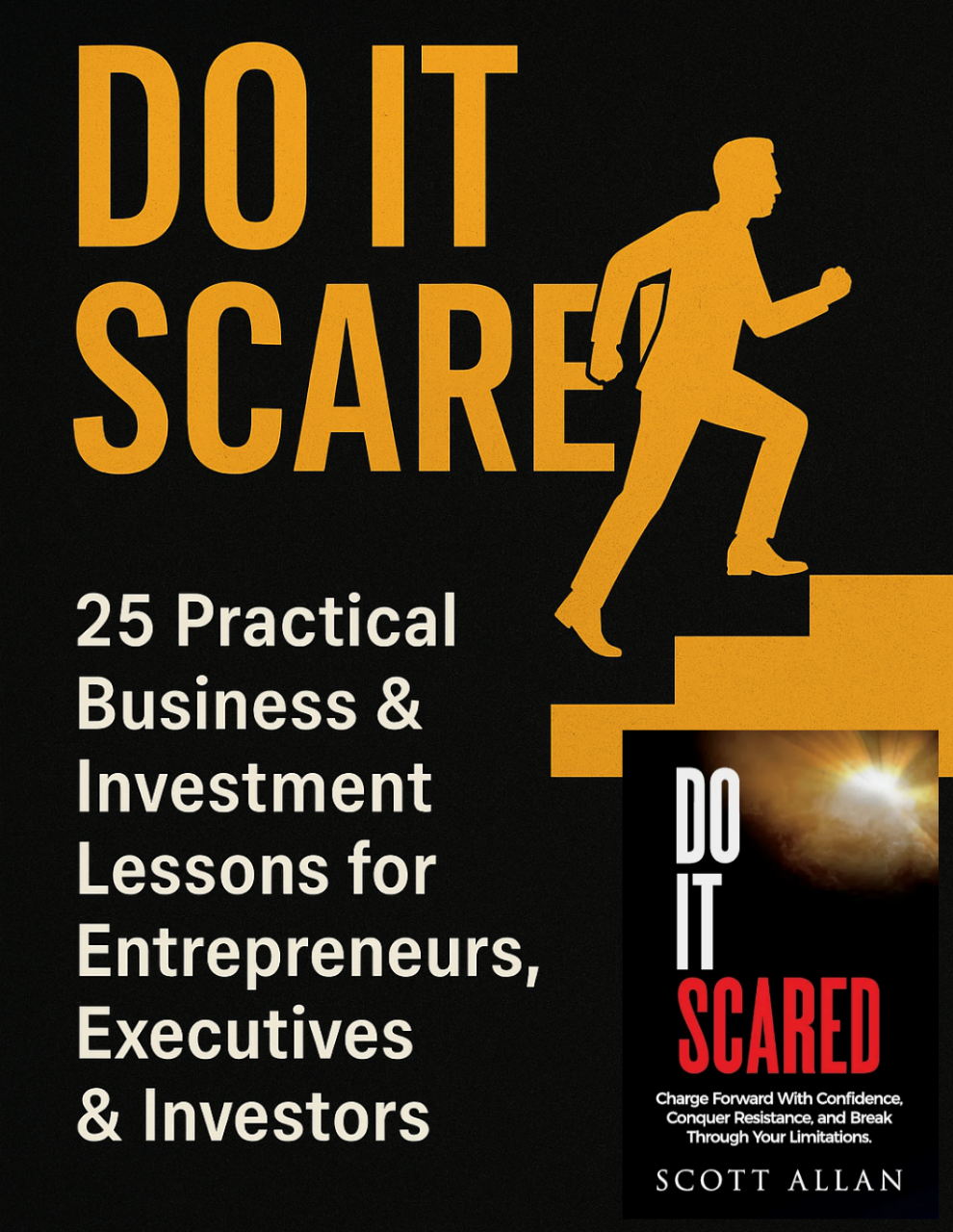If you’re an entrepreneur, investor or business leader looking to build sustainable success, one of the often overlooked — yet massively powerful — levers is habit. Over my 20+ years in business and investing, I’ve found that it’s rarely the dramatic strategy or one big bet that wins; instead, it’s the consistent small actions, repeated day in and day out, that create the real difference. That’s exactly why I want to unpack the book Atomic Habits: An Easy & Proven Way to Build Good Habits & Break Bad Ones by James Clear for you — not just as a reader, but as a business-practitioner.
I’ll pull out 25 concrete lessons (yes, 25!) that you can apply to entrepreneurship, business growth and investment-mindsets, and we’ll go step-by-step so you grasp them even if you’re relatively new to habit design.
Book Overview: Genre, Author, General Description
Atomic Habits is a non-fiction self-help / business-improvement book published in 2018 by James Clear.
The genre: practical psychology + systems for behaviour change. Clear draws on habit-formation research in psychology, neuroscience, business and performance to propose a system for building good habits and breaking bad ones.
In short: small changes compound; the system matters more than the goal; identity drives behaviour. Clear frames how habits work (cue → craving → response → reward) and builds a set of laws to design habits. For entrepreneurs and investors, the implications are profound: your day-to-day routines create your performance curve, your systems produce your results, not simply your lofty goals.
25 Practical Lessons for Entrepreneurs, Business Leaders & Investors
Below are 25 lessons drawn from the book — re-interpreted through the lens of business and investing — with analogies, step-by-step logic, and simplified so you can implement them.
1. Focus on Systems, Not Just Goals
Lesson: In business you often set big goals (“I want to double revenue” or “I want to pick the next breakout startup”). But Clear reminds us: “You do not rise to the level of your goals. You fall to the level of your systems.”
Analogy: Think of a goal as the mountain you want to climb. The system is the path, the daily steps, the gear, the rest stops. Without a good path, you may never reach the top.
Implementation: Instead of saying “I’ll invest in 10 companies this year”, design a system: block time every Monday for deal sourcing, build a checklist, track outreach. Over time the system carries you.
2. Small Improvements Compound
Lesson: Tiny habits improve your trajectory. Clear gives the example: getting 1% better each day eventually yields dramatic results.
Analogy: If you deposit a little bit of money regularly, compounding interest makes it grow huge. Habits are the compounding interest for your performance.
Implementation: As an entrepreneur: spend 10 minutes each day reading market insights. Over a year, you’ll accumulate a body of knowledge that differentiates you.
3. Identity-Based Habits Drive Behaviour
Lesson: The key is not “what do I want to achieve?” but “who do I wish to become?” Your habits vote for that identity.
Analogy: If you label yourself “I am an investor”, then you naturally do investor-type habits (reading deals, networking). If you label “I am a speculator”, you act differently.
Implementation: Define: “I am a disciplined investor who does due diligence weekly.” Then each habit (e.g., reviewing a term sheet) becomes a vote for that identity.
4. Habit Loop: Cue → Craving → Response → Reward
Lesson: Understanding the four steps helps you design habits.
Analogy: It’s like a loop on autopilot: you see a cue (alarm clock), you crave (comfort of sleep), you respond (hit snooze), you reward (extra few minutes).
Implementation: For business: Cue = your CRM dashboard prompts you. Craving = feeling of being on top of deals. Response = you log outreach. Reward = you mark the task done and feel progress.
5. First Law: Make It Obvious
Lesson: To build a good habit, make the cue obvious. To break a bad habit, make the cue invisible.
Analogy: If you want to exercise, lay your gym clothes the night before so you see them immediately. If you want to stop snacking, hide the snacks out of sight.
Implementation: Entrepreneur: Put your goal metrics on a whiteboard where you’ll see them daily. Investor: Set a calendar reminder “deal sourcing review” so you don’t overlook it.
6. Second Law: Make It Attractive
Lesson: Make the habit appealing so you’re drawn to it. Use temptation-bundling.
Analogy: You pair something you like (watching a favourite video) with a habit you need (doing your bookkeeping).
Implementation: As an investor: only allow yourself to check your favourite market blog after you’ve done your pipeline mapping for the week. This bundling makes the necessary habit more attractive.
7. Third Law: Make It Easy
Lesson: Reduce friction. Lower the barrier to the habit.
Analogy: It’s easier to run when your shoes are already by the door than when they’re still in the shoebox in the cupboard.
Implementation: Entrepreneur: Automate your weekly performance summary via a template so it takes 15 minutes rather than an hour.
8. Fourth Law: Make It Satisfying
Lesson: Give yourself immediate gratification (a felt reward) so the habit sticks.
Analogy: A child does homework because at the end they get a sticker or praise — immediate satisfaction helps the chain.
Implementation: After you complete your investor review meeting, mark the achievement on a visible tracker or treat yourself to a coffee. That small reward reinforces the habit.
9. Use Habit Stacking
Lesson: After an existing habit, attach a new one (“After X, I will Y”).
Analogy: If you already brush your teeth, after that you’ll write one page of your business journal.
Implementation: As an entrepreneur: After you send your daily team update email, you’ll open your “idea notebook” for 5 minutes to jot new growth ideas.
10. Environment Design Trumps Motivation
Lesson: Rather than relying purely on willpower, shape your environment to make good habits the default.
Analogy: If you want to read more, leave the book on your pillow so it’s the last thing you see at night.
Implementation: For business: Clear your inbox at day’s end so the morning starts fresh, cueing you into focused work instead of being overwhelmed. Investor: Set up your workspace so deal documents are pre-loaded, notifications silent.
11. Make Bad Habits Difficult
Lesson: Flip the laws: Make the cue invisible, the craving unattractive, the response difficult, the reward unsatisfying.
Analogy: To stop checking social media, delete the apps from your phone so the cue is gone; make it harder to respond.
Implementation: Entrepreneur: If you tend to waste time on unproductive meetings, require yourself to fill a justification form before scheduling them — extra friction helps you reconsider. Investor: If you tend to skip due diligence, set a rule: no funding until five key analysis steps are completed.
12. Track Your Habits Visually
Lesson: Habit tracking (calendar marks, charts) gives immediate feedback.
Analogy: A chain on the wall gets longer and it motivates you not to break it (“don’t break the chain”).
Implementation: Keep a visual tracker of your deal calls each week, or a streak of “review business metrics” each morning. The visible progress encourages you to keep going.
13. Never Miss Twice
Lesson: It’s okay to slip once, but missing two in a row often starts a downward spiral of bad habit.
Analogy: If you skip exercise one day, you can catch up. Skip two days and it becomes much easier to skip three.
Implementation: As an entrepreneur: If you miss your weekly strategy meeting, ensure you attend the next one regardless of how busy you are. For investing: If you miss your weekly deal-sourcing time, double up the next session.
14. Choose the Right Field of Competition
Lesson: Align your habits with your strengths and inclinations — pick where you can win by being different, not just better.
Analogy: You wouldn’t swim competitively if you hate being in water; you’d pick running. In business, pick a field you enjoy and are naturally aligned with.
Implementation: If your investor strength is in emerging markets, build habits around sourcing early-stage deals there rather than competing in crowded Silicon Valley rounds.
15. Use the Two-Minute Rule
Lesson: “When you start a new habit it should take less than two minutes to do.”
Analogy: You don’t start reading by saying “I’ll read 100 pages now.” You say “I’ll read one page.” Then often you read more.
Implementation: Entrepreneur: “I will draft my morning metrics email in 2 minutes.” Investor: “I will scan one new pitch deck today.” Small starts build momentum.
16. Habit Contracts & Accountability
Lesson: Make habits more likely by creating a contract, social accountability or penalty for failure.
Analogy: If you bet a friend you’ll run every morning and you’ll pay them if you don’t, you’ll feel social pressure to stick with it.
Implementation: Business: Commit publicly to your team that you’ll present weekly, and invite them to call you out if you don’t. Investment: Form an investing partner group where each member holds others accountable for decision deadlines.
17. Identity Flexibility and Review
Lesson: Even good habits can plateau; reflect and refine your identity and system.
Analogy: An athlete doesn’t just train the same way forever; they review performance, adapt new drills.
Implementation: Every quarter, ask: “Who do I want to become as a business leader/investor?” Then adjust habits and systems accordingly.
18. Habits First, Goals Later
Lesson: Focus on building the habit system; goals are useful for direction but not sufficient for execution.
Analogy: You map your destination (goal), but you walk the path (habits). If you only watch the destination, you ignore the steps.
Implementation: As an entrepreneur: instead of solely “grow revenue by 30%”, set the habit: “Every Monday review and act on top-5 growth metrics.” For investing: “Every Wednesday read one industry report.”
19. Avoid Identity Conflict
Lesson: The reward and habits must align with the identity you want — conflicting rewards undermine the habit.
Analogy: If you want to be a “healthy investor” but reward yourself with junk food after each successful deal call, your identity conflicts.
Implementation: Choose rewards that reinforce your identity: treat yourself to a business-book purchase rather than a guilty snack.
20. Social Influence and Culture Matters
Lesson: Your habits are shaped by the cultures you belong to: family, friends, colleagues, investors.
Analogy: You adopt the accent of the region you live in. Similarly, you adopt habits of the people you spend time with.
Implementation: Surround yourself with entrepreneurs/investors who review deals weekly, read industry news daily — their habits influence yours.
21. Use “Implementation Intention”
Lesson: Decide in advance when and where you will act: “When X happens, I will do Y.”
Analogy: If you decide “When the clock strikes 8 pm, I will review tomorrow’s agenda”, you’re more likely to do it.
Implementation: Investor: “When I finish my lunch at 1pm, I will spend 15 minutes scanning LinkedIn for co-investors.” Entrepreneur: “When I shut down work at 6pm, I will spend 10 minutes planning tomorrow’s top 3 tasks.”
22. Embrace the Plateau of Latent Potential
Lesson: The biggest changes often come after a long period of little visible progress. Time amplifies results.
Analogy: A seed lies dormant before a tree sprouts visibly — you don’t see the roots growing underground.
Implementation: If you’re building a sales funnel, initial weeks may show little traction — but keep showing up, refining, the compound effect will kick in.
23. One Bad Day Doesn’t Ruin You — But Two Might
Lesson: Missing a habit once is okay; missing twice in a row often triggers a new bad pattern. (Similar to Never Miss Twice)
Analogy: If you skip a workout once, no big deal; skip twice and the energy drains, you stop entirely.
Implementation: Business: If you miss your weekly team review one week, ensure you still do it next week — hold yourself accountable. Investing: If you miss your deal screening time this week, block two slots next week.
24. Habits Are Not About Restriction — They Create Freedom
Lesson: Good habits free you from decision fatigue and reactive living.
Analogy: Once you automate paying your bills, you don’t think “Should I pay bills?” — it’s done. Your time is freed for higher leverage work.
Implementation: Entrepreneur: Automate repetitive administrative tasks so you focus on high-impact strategy. Investor: Automate alerting/listing of new deals rather than manually scanning every day.
25. Review, Reflect & Refine
Lesson: Habits are not “set and forget”. Periodic review keeps them sharp and aligned.
Analogy: Even a well-running car needs tune-ups. Habits need check-ins.
Implementation: End of each quarter, review: Which habits are working? Which are frictional? What identity do I now need? Then adjust your system.
The Book: Atomic Habits – An Easy & Proven Way to Build Good Habits & Break Bad Ones

You can buy the paperback at a discount rate from Bookshop.org.
Practical Quizzes (one per lesson)
- What is the difference between a goal and a system in your business context?
- If you improved by 1% every day for a year, how might that compound in your investment or business results?
- What identity do you currently hold (entrepreneur/investor), and what habits are you voting for that identity?
- In your regular workflow, identify the cue → craving → response → reward loop for one habit you want to build.
- Name one way you could make a desired business habit more obvious in your environment.
- How could you make a habit attractive in your investor workflow?
- What’s one habit you could make easier by reducing friction in your systems?
- Identify a small reward you could attach immediately after a business habit so making it satisfying.
- Choose an existing habit and attach a new small habit after it (habit stacking). What is it?
- What change could you make in your work environment to make your productive habits the default?
- Name one bad habit (business or investing) you can make more difficult to do by increasing friction.
- How will you visually track a key habit for your business or investing?
- If you miss your habit this week, what is your plan to ensure you don’t miss twice?
- What field of competition have you chosen for your enterprise or investing, and do your habits align with it?
- What two-minute version of a habit could you start today?
- How might you create an accountability contract for one key habit in your business or investing?
- How often do you review your identity and the habits associated with it? When is your next review?
- What is your habit-system right now (rather than your goal) for a major business outcome?
- Think of a reward after your habit that might conflict with your identity — how will you change it?
- What social group/peer circle influences your habits, and does that group support your desired identity?
- Formulate an “implementation intention” for one habit: “When X, I will Y.”
- Recognize a period in your business where you had little visible progress — how did you stay consistent despite the plateau?
- If you skip one day of a habit, what will you do to ensure you don’t skip the next?
- What habit are you automating in your business or investing so you free yourself for higher-leverage work?
- At the end of this quarter, how will you review which of your habits are working, which need adjustment, and what identity you need to embody?
FAQs & Answers
Q1. Isn’t goal-setting enough?
A: No. Goals give direction, but without systems you’ll struggle to execute. Clear emphasizes the system is what drives results.
Q2. If I have willpower, can’t I just decide and do the habit?
A: Willpower helps, but it’s unreliable. Habit systems reduce reliance on willpower by designing the environment and automating behaviours.
Q3. How small is “atomic”?
A: It means very small — the smallest meaningful unit of behaviour. Something so easy you can’t say “I’ll do it later”. Over time, these scale.
Q4. How long until a habit sticks?
A: There’s no fixed timeline. But consistency matters more than time — often you’ll see visible results after the compound effect kicks in.
Q5. Can I apply these habit principles to business teams, not just myself?
A: Absolutely. The same laws work for teams: design obvious cues (dashboard alerts), make habits attractive (team rituals), make easy (processes), make satisfying (celebrations).
Q6. What about breaking bad habits?
A: Use the inversion of the Four Laws: make the cue invisible, craving unattractive, response difficult, reward unsatisfying.
Q7. What if I slip and fail?
A: One slip is not catastrophic. The key is to show up again as soon as possible. Missing twice is when the spiral starts.
Q8. How do I pick which habit to build first?
A: Choose one that aligns with your identity and gives visible progress early. Implement the two-minute version to start.
Q9. Will these work for investors who are busy?
A: Yes. The value for investors is designing daily, predictable habit loops (deal-sourcing, reading, network outreach) rather than relying on occasional big wins.
Q10. Is this book just for individuals or for organizations too?
A: While the book focuses on individual behaviour, the principles scale to teams and organizations: culture is essentially shared habits.
Concise Review & Rating
Atomic Habits by James Clear is a highly practical and actionable manual for building consistent habits. For entrepreneurs, business leaders and investors, its focus on systems, identity and small-scale improvements is especially valuable. The framework is clear, well-illustrated and grounded in research and applied examples.
If I were to rate it (on a scale of 1-5 in its genre of business/self-improvement books), I’d give it 4.5/5 — it’s near essential reading, especially for those committed to sustainable growth rather than quick fixes.


